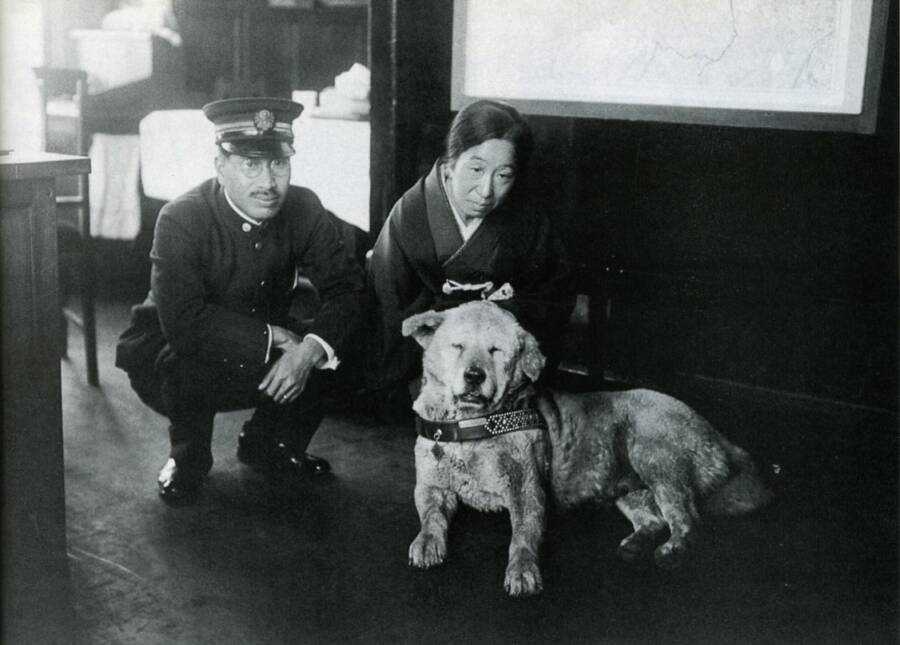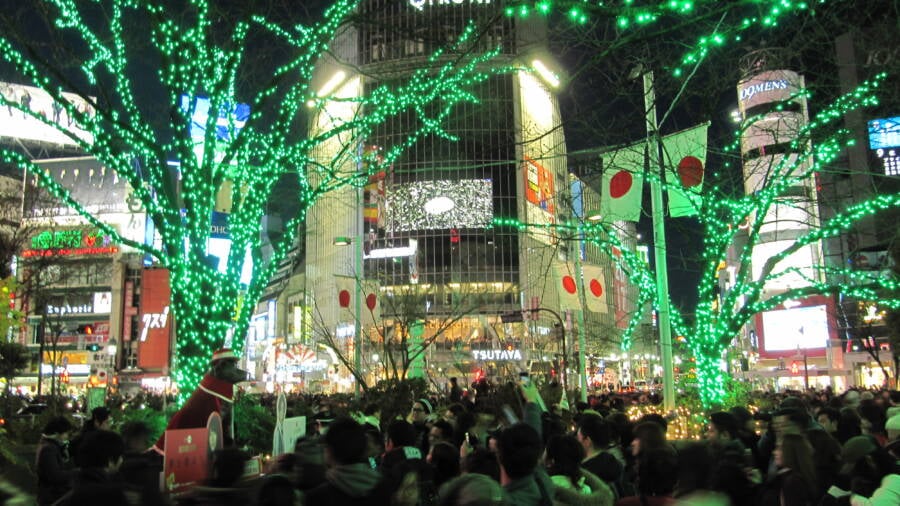The bronze statue of Hachikō the Akita that stands outside of Shibuya Station in Tokyo memorializes the loyal dog who spent nearly 10 years waiting for a train to bring his dead owner home.

Felix Choo / Alamy Stock PhotoThe statue of the famous Akita dog Hachikō outside of Shibuya Station in Tokyo.
Outside of Shibuya Station in Tokyo stands the beloved Hachikō statue, a bronze monument to one of Japan’s most famous dogs. Hachikō the Akita is best remembered for his unwavering loyalty. Every evening, the dog would wait at the train station for his owner, Professor Hidesaburō Ueno, so the two could walk home together.
Unfortunately, Ueno died suddenly from a brain hemorrhage while teaching in May 1925. Hachikō, as always, went to meet his master at Shibuya Station after work — but he never arrived. However, the loyal Akita continued to trek to the station to wait for Ueno every day for the next 10 years.
The dog’s story quickly spread throughout Japan, drawing national attention. People traveled from all over to see the faithful pup waiting for an owner who would never return, and he became a symbol of loyalty. He grew so popular that in April 1934, sculptor Teru Andō unveiled a bronze statue of Hachikō at Shibuya Station, with the famous dog in attendance.
But the story of the Hachikō statue is just as captivating as the life of the dog it was made to honor.
The Heartbreaking Story Of The Loyal Akita

Public DomainHachikō patiently waiting for his owner at Shibuya Station in 1933.
Hachikō was born on Nov. 10, 1923, on a farm near the city of Ōdate in the Akita Prefecture of Japan (where his breed gets its name), and he was adopted by Hidesaburō Ueno in 1924. Ueno, a dog lover, walked with his faithful canine to Shibuya Station every morning. There, the professor would take the train to Tokyo Imperial University, where he taught agricultural science. Ueno would then return to Shibuya Station after finishing classes for the day to find Hachikō waiting to accompany him home.
“When Professor Ueno returned… he found Hachikō at Shibuya Station, and he was happy to see Hachikō and gave him lots of love,” museum curator Keita Matsui told The Japan Times in 2023. “So, Hachikō must have thought that if the professor was absent for a long time, he could see the professor at the station.”
This routine continued for more than a year until Ueno tragically suffered a fatal cerebral hemorrhage at work one day. However, Hachikō was not deterred. Day after day, he returned to Shibuya Station, waiting for Ueno to step off the train. At first, the station employees considered the dog to be a nuisance, unaware that he was waiting for his late master. Over time, though, they came to love Hachikō and would often sit with him and give him treats. The Akita became so popular that the first Hachikō statue was erected to honor him even before his death.
The loyal pup continued to wait for his late master for nearly 10 years. Despite his own health issues and weakening legs, he would walk each day to Shibuya Station and watch for Ueno. Then, on March 8, 1935, Hachikō was found lying dead on a street near the train station, faithful to the very end.
As the news of the dog’s death spread, crowds gathered at the Hachikō statue that had been unveiled a year earlier to honor his memory.
How The First Statue Of Hachikō Came To Be
Hachikō first made national news in 1932 after one of Ueno’s former students, Hirokichi Saito, caught wind of the Akita’s loyalty and went to Shibuya Station to see for himself if the rumors were true. Sure enough, he saw Hachikō waiting for the professor’s train and followed him to the home of Ueno’s former gardener, Kozaburo Kobayashi. Kobayashi told Saito about the dog’s story, and Saito developed a deep fascination with the Akita breed as a result.

Public DomainA crowd of people at the original Hachikō statue on March 8, 1936, the first anniversary of the dog’s death.
Shortly after, Saito performed a census of purebred Akitas in Japan. To his surprise, there were only 30 in the country. Saito continued to visit Hachikō at Shibuya Station and eventually published several articles about the dog’s remarkable devotion to his owner. One of these reports was printed in the Japanese newspaper The Asahi Shimbun, and it skyrocketed Hachikō to national fame.
Two years later, sculptor Teru Andō unveiled the first Hachikō statue at Shibuya Station in dedication to Japan’s most loyal dog. However, this isn’t the same bronze monument that stands there today. Andō’s original work was recycled for metal during World War II. Thankfully, when the war ended, Andō’s son was around to recreate the Hachikō statue and keep the pup’s memory alive.
The Second Hachikō Statue That Still Stands To This Day

Pablo/Wikimedia CommonsA crowd of people standing around the Hachikō statue in December 2016.
In 1948, Takeshi Andō, the son of Teru Andō, was commissioned to recreate his father’s statue of Hachikō. When the work was completed that August, a dedication ceremony was held, and the station entrance nearest to the statue was renamed “Hachikō-guchi,” which translates to “The Hachikō Entrance/Exit.”
The monument still stands in the same spot today, and every year, on the anniversary of Hachikō’s death, a ceremony of remembrance is held that attracts hundreds of people.
However, this is not the only statue dedicated to Hachikō’s memory. Another monument was built in front of Ōdate Station in the city where the beloved dog was born, and a third statue was erected in 2004 outside of the Akita Dog Museum in Ōdate. Then, in 2015, faculty in the agriculture department at the University of Tokyo (formerly Tokyo Imperial University, where Hidesaburō Ueno worked) unveiled another bronze statue of the loyal pup. This time, however, the monument featured both Hachikō and Ueno, showing the two greeting each other at the train station.

coward_lion / Alamy Stock PhotoThis statue of Hachikō and Professor Hidesaburō Ueno was unveiled at the University of Tokyo in 2015.
Remarkably, despite being erected more than 75 years ago, the statue of Hachikō at Shibuya Station has never been damaged. Perhaps this is due to the unyielding love and respect people have for the late Akita, who many consider to be the most loyal dog of all time.
Clearly, the story of Hachikō and Professor Ueno still affects people deeply nearly a century later. As one expert told The Japan Times, Hachikō remains so beloved today “because the dog resonates with people of all ages, genders, and nationalities, and overlaps with the experience we all have of wanting to meet someone we love but being unable to.”
After reading about Japan’s beloved Hachikō statue, learn about the lives of more of history’s famous dogs. Then, go inside the true story of Balto, the heroic husky.





